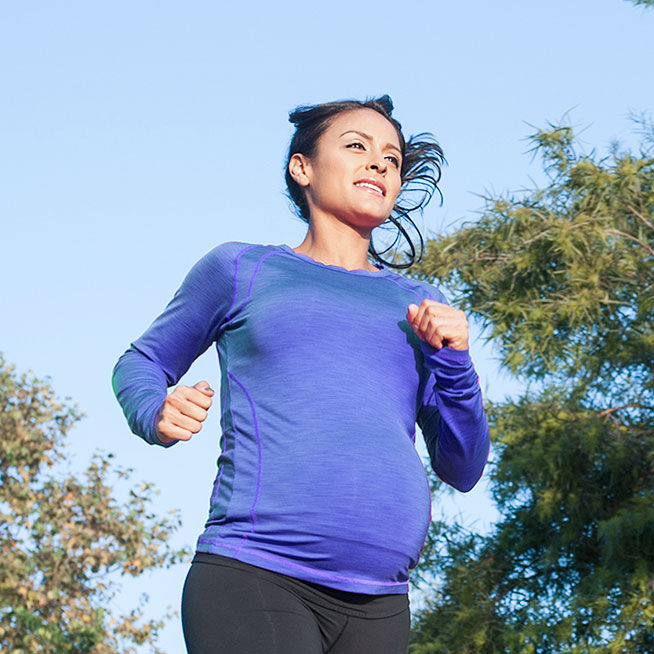Danone Specialized Nutrition (Malaysia) Sdn Bhd supports exclusive breastfeeding for your infant’s first six months of life. After six months of age, infants should receive age-appropriate complementary foods while breastfeeding continues for up to two years of age or beyond. Consult your doctor before deciding to use infant formula or if you have difficulty breastfeeding.
Types of Safe Exercises During Pregnancy & The Benefits
Pregnancy exercise benefits
The benefits of exercise during pregnancy are well documented. Numerous studies have proven it has a positive effect on both the expectant mum’s health and her little one’s health. That’s why we’re encouraging women to get Active for 2, whether that’s by going for a simple swim or a gentle jog.
Pregnancy exercise does much more than improve your well-being – it can support the development of your little one’s heart and brain too. If you’re struggling to find motivation, these facts about the benefits of pregnancy exercise may help get you started.
Why exercise in pregnancy?
The benefits of pregnancy exercise for mum
Pregnancy exercise can improve your experience of pregnancy in many ways. Studies show that exercising mothers:
- Experience less lower back pain1, pregnancy constipation8 and tiredness9.
- Are 30% less likely to develop gestational diabetes2.
- Are less likely to need an unplanned caesarean3,4.
- Experience fewer incidences5 and reduced severity6 of depression.
- Gain less weight during pregnancy4.
- Are less likely to develop urinary incontinence7.
- Have reduced incidents of pregnancy constipation8.
- Experience less tiredness in pregnancy9.
- May have shorter labour1.
Feeling motivated? Discover how to exercise safely during pregnancy.
What exercise can I do while pregnant?
There are a number of activities designed specifically for expectant mums, like pregnancy yoga. But if you love to run, swim or go to the gym, you should be able to continue your usual routine with a few modifications. Remember, some days you may feel more energetic than others, so always take things at your own pace.

Running
Running or brisk walking is free and can be done anywhere, anytime. Even a gentle jog or a walk in the park can raise your heart rate enough to be beneficial.

Swimming
Swimming during pregnancy is relaxing for the mind and low impact on the body. Most swimming strokes are safe10, including backstroke – although you may want to avoid breaststroke if you have symphysis pubis dysfunction (SPD)11.

Strength training
Strength training exercises, using moderate rather than heavy weights, is normally safe to continue with if weights are part of your usual exercise routine. But you may need to make a few modifications.

Yoga
Pregnancy yoga is great for helping you wind down, connect with your little one and retain strength and flexibility.
Before you start, do consult your doctor or midwife to let them know which activities you plan to engage in. And read up on which exercises you should avoid during pregnancy. And when you do get started, whatever your fitness levels or stage of pregnancy, listen to your body. If you feel too tired, your heart is racing or you feel dizzy, stop and rest.
References:
1. Pennick V, Liddle SD. Interventions for preventing and treating pelvic and back pain in pregnancy. Cochrane Database Syst Rev 2013(CD0011):1-100.
2. Sanabria‐Martínez G et al. Effectiveness of physical activity interventions on preventing gestational diabetes mellitus and excessive maternal weight gain: a meta‐analysis. BJOG 2015;122(9):1167-74.
3. Price BB et al. Exercise in pregnancy: effect on fitness and obstetric outcomes-a randomized trial. Med Sci Sports Exerc 2012;44(12):2263-9.
4. Domenjoz I et al. Effect of physical activity during pregnancy on mode of delivery. Am J Obstet Gynecol 2014;211(4):401.e1-e11.
5. Gaston A, Prapavessis H. Tired, moody and pregnant? Exercise may be the answer. Psychol Health 2013;28(12):1353-69.
6. Robledo-Colonia AF et al. Aerobic exercise training during pregnancy reduces depressive symptoms in nulliparous women: a randomised trial. J Physiother 2012;58(1):9-15.
7. Perales M et al. Benefits of aerobic or resistance training during pregnancy on maternal health and perinatal outcomes: A systematic review. Early Hum Dev 2016;94:43-8..
8. Shi W et al. Epidemiology and risk factors of functional constipation in pregnant women. PloS one 2015;10(7):e0133521
9. Gaston A, Prapavessis H. Tired, moody and pregnant? Exercise may be the answer. Psychol Health 2013;28(12):1353-69.
10. Juhl et al. Is swimming during pregnancy a safe exercise? Epidemiology 2010;21(2):253-8.
11. Tommy’s. Pelvic pain in pregnancy (SPD). [Online]. 2018. Available at: https://www.tommys.org/pregnancy-information/pregnancy-complications/symphysis-pubis-dysfunction-spd-or-pelvic-girdle-pain [Accessed June 2020].
Aptamom Bar: Maternal Cereal Bar
Aptamom bar is a ready-to-eat, delicious cereal bar for pregnant mothers. It provides pregnant mothers a convenient way to obtain the essential nutrients and vitamins that are needed more of during pregnancy.

Connect with our team of experts
We provide advice and support for you on your parenthood journey.



